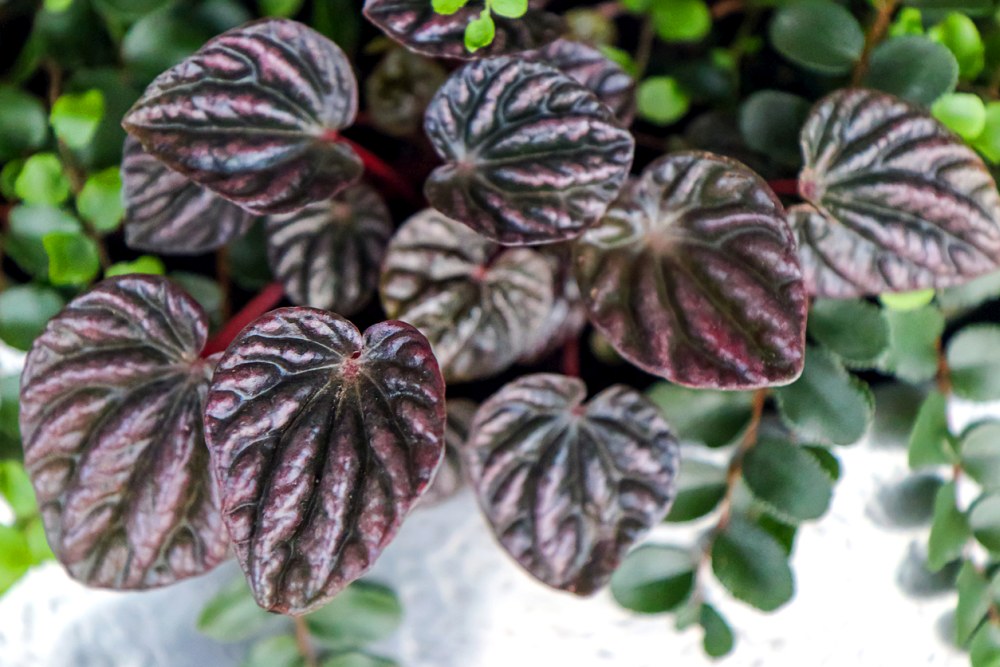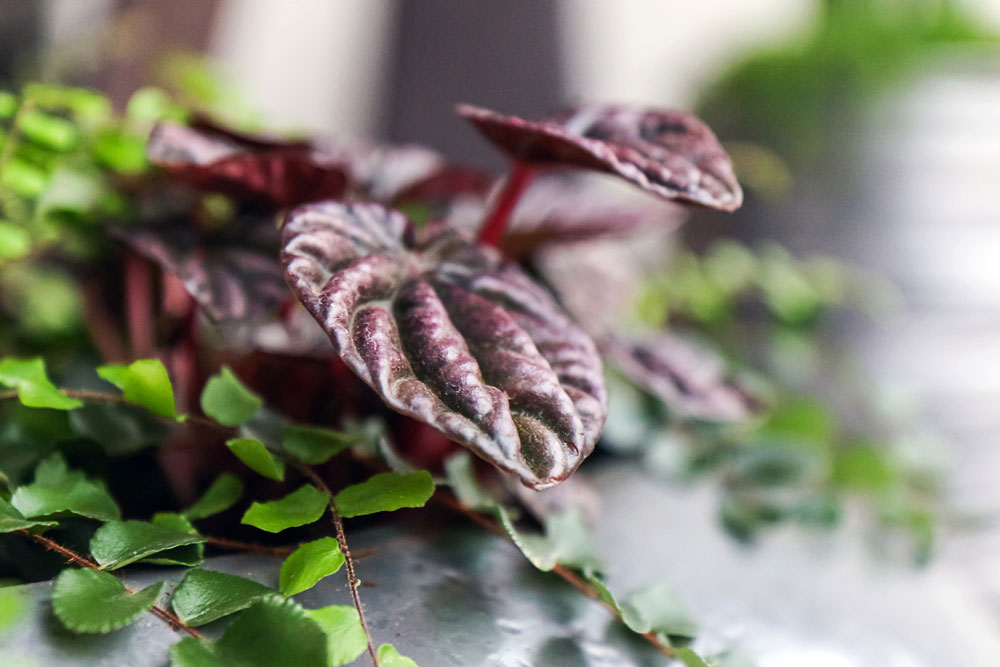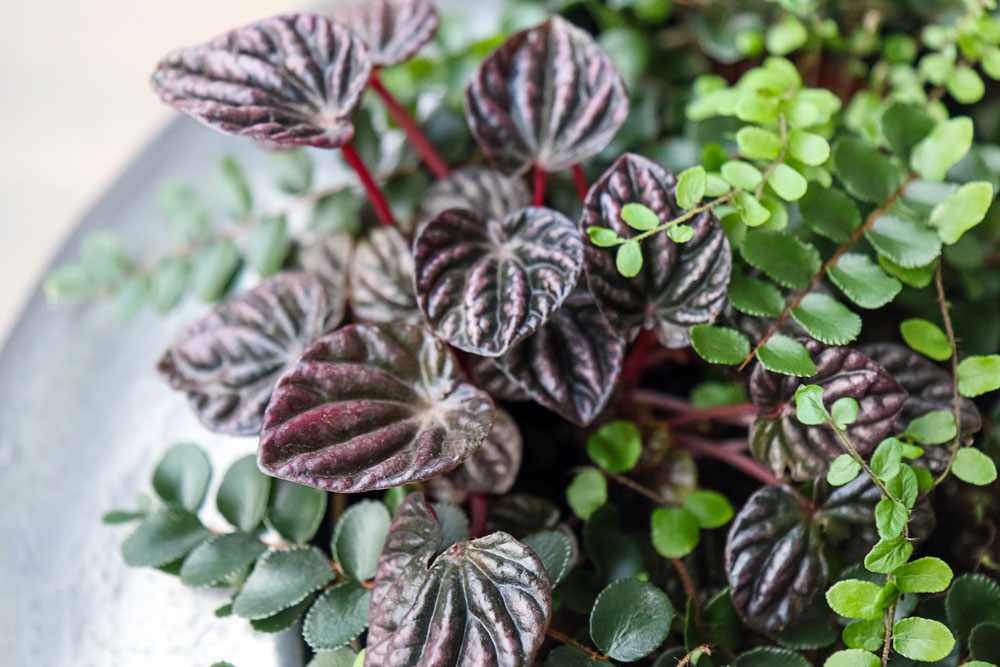Peperomia Caperata Care: How to Grow and Nurture Your Emerald Ripple Plant
You can't ignore the fact that Peperomias are vigorously taking huge strides over about other semi-succulents retailing at gardening stores. And it's more reason why we love to creepo out solid write-ups on how to intendance for diverse cultivars in the Pepiraceae family.
In this particular guide, nosotros'll look into all the bits and pieces you need, to routinely proceed your Peperomia Caperata as pretty equally a picture show.

More than About The Peperomia Caperata
Coming from the tropical parts of South America, Brazil to be exact, this semi-delicious is perfectly adapts to an indoor setting, so long as you can patently tweak the surrounding weather which nosotros'll point upwards later on in this guide.
The Peperomia Caperata, also known as the Emerald Ripple, is quite famed for its night-dark-green leaves with deep veins in various shades of cream, ruby-red and greyness. Amid the g varieties in this the Peperomia genus, this houseplant is quite treasured by many households for its long-winded threshold to put upwards with varying growing weather.

What mostly makes this cultivar glow different is the richly ruffled design on the leaves that makes the entire foliage look and then highly-seasoned and graceful every season of the year. But making your Emerald Ripple bloom up without shying off takes some bits of endeavour.
While it thrives nether USDA hardiness zones 11-12 across various states in the United states of america, preferably outdoors on the ground, information technology's quite surprising how most households adopt it as an indoor plant.
How Large Does It Abound?
Just to accept a rough estimate, the Emerald Ripple Peperomia has a beefed-up potential to hitting about 8″ inches, both in height and width. Well, that's non much. It'southward naturally a miniature constitute and then don't hold too many prospects when it comes to its utmost burgeoning capacity.
As a compact houseplant, taking plentiful care of the Peperomia Caperate literally takes less effort. Other matching Peperomia varieties you might come up across include:
- Watermelon Peperomia
- Peperomia Silver Ripple
- Raindrop Peperomia
- Peperomia Cerise Cascade
- Peperomia Hope
Caring Tips For The Emerald Ripple
Soil & Transplanting
If you want to abound your Emerald Ripple equally a houseplant, it's all-time to use normal potting soil for succulents. I prefer to use the African Violet potting mix someday I'one thousand planting a cultivar in my garden. It's more porous and lets water drain though much quicker than other soil mixtures.

I'd likewise recommend using the post-obit ingredients when preparing the potting soil, to modify the texture and arrive nutrient-rich:
- I office of normal garden soil
- A portion of peat moss, leaf molding, or humus
- One office of perlite or sand
While you're at information technology, information technology's worth noting that using a growing medium with enough drainage holes, helps protect the roots from decaying since the water won't get stuck in the soil for too long. Succulents are well-nigh often prone to root rot, so you can't overlook using soil that's permeable enough to allow water to drain through with less effort.
To calibrate the soil's pH, ideally by making it less acidic and more alkali metal, y'all tin can better it with limestone since it contains both calcium carbonate and magnesium carbonate. These two compounds help the soil have the essential nutrients that allow you Emerald Ripple Peperomia to grow at an optimal rate.
You also want to employ soil that's fairly loose and then information technology tin requite room for air circulation.
You don't really need to re-pot this houseplant for the simple fact that it grows compactly. But should it be necessary, the best time to re-pot your Emerald Ripple institute is during spring considering it's an ideal growing season.
Likewise, you don't have to transplant it into a big pot since the roots of this variety don't elongate wildly.
Flowering & Fragrance
Although Peperomias have a bountiful potential to glam up your abode quite gracefully, they aren't the all-time flowering houseplants you'll e'er come across. You lot might spot a few tiny flowers—popularly labeled as mouse tails during jump, but they ordinarily take no odour and sprout at the tips of mature stalks.
Watering & Feeding
You'll only need to h2o this Peperomia variety more frequently during the growing seasons. It sprouts and blooms flowers around jump till the end of the fall flavour. Throughout these 2 seasons, you want to gently h2o your Emerald plant at even intervals. Be conscientious not to wet the rosette since it'll brainstorm to rot. Instead, just water the topsoil and leave it to dry out completely.
Before watering your plant again, check if information technology's showing any acute signs of wilting. That would be such a fruitful approach to lay out a consistent watering schedule.
Oft, the leaves turn yellow when you betrayal your plant to extremely wet conditions for long hours. Peperomias catch diseases and the roots brainstorm to rot if they grow in soggy soil.
Your houseplant likewise needs soluble fertilizer every once per calendar month during summer and jump, to speed upwardly the growth rate. Peperomias yield quickly when y'all use a well-balanced xx-20-20 fertilizer that holds equal portions of potassium, iron, and nitrogen. Remember to dilute it with water and avert fertilizing your institute during winter when the temperatures are freezing.
Light, Humidity & Temperature
Your Peperomia Caperata grows all-time where in that location's vivid, indirect light admission. So if y'all're growing it indoors, place it close to a window facing east or west, to give it at least 4 hours of sunlight each day. But if your living infinite is dull, grow lights would equally work just fine.
While low light conditions crusade your Emerald Ripple to abound at a stunted rate, too much of it will botch and discolor the leaves. The ideal room temperature this houseplant needs to abound under should be anywhere between 15- 27 degrees Celcius, thereabout.
If the temperature falls beneath this marking, your constitute might begin to exhibit stunted growth or gravely suffer from pathogenic fungi.
You as well want to go along the humidity levels moderately loftier, preferably effectually 40-50%. If it'due south hard to naturally achieve this humidity level, you can sacrifice a few bucks and buy a digital humidifier for houseplants.
Pruning
You won't need to worry much about grooming your Emerald Ripple Peperomia since it hardly forms jungly foliage, except for when you're depriving it of the essential macronutrients such as copper, manganese, iron, and zinc.
Apply a pair of scissors to trim the edges of the constitute to make it have a fluffy and even advent. Fifty-fifty though this is a deadening-growing houseplant, new nodes will develop, and then long as you're giving it the most tenable growing conditions.
How to Propagate Your Emerald Ripple
Y'all can easily propagate this Peperomia diversity through;
- Leaf cuttings
- Division
- Stem cuttings
But the method which I find quite nifty and helpful is using leaf cuttings. Simply follow these steps and you lot'll see results in about four weeks or even less:
- Cut the leaf where the petiole attaches itself to the stem from the female parent establish.
- Put it exterior to dry out for a few hours to give the edge of the petiole some grace period to heal.
- Dip information technology in rooting hormone to speed upwardly the growth of new roots.
- Fix the potting soil using the formula we vouched for in this guide.
- Establish the cuttings in an upright position and gently clasp the topsoil downwardly and then they tin can have a firm support base of operations.
- Put the growing medium under vivid, indirect light and h2o your establish once every ii weeks.
- It will probably have about 4 weeks for the roots to brainstorm sprouting, so y'all need to exist a niggling patient.
Common Pests & Diseases
For the almost part, your Emerald Ripple Peperomis won't struggle with any serious pests or diseases. Information technology's but prone to the side effects of overwatering which include root rot and a bunch of dreadful fungal diseases. If the leaves begin to turn yellow and wilt, that could also be an acute sign of overwatering. It also causes the plant to exhibit a stunted growth charge per unit.
Don't miss to utilise soil that's well aerated—to allow air circulation and permit water bleed through much quicker. If water gets stuck in the soil for too long, it cuts the oxygen supply, causing your found not to have an easy aerobic respiration process. If this happens, it'll be hard to redeem your plant back to its initial condition. Some of the common pests y'all also want to watch out for include spider mites, mealybugs, scale, and whiteflies.
Always go on this multifariousness nether room temperature of between 15-18 degrees celsius to keep it from leaf loss. The leaves might as well wilt and drop at an alarming stride if y'all feed your Emerald Ripple establish with as well much fertilizer.
Emerald Ripple Benefits & Uses
This cultivar looks awesome when grown as a houseplant, preferably where information technology tin can have access to filtered light. I'd suggest placing it almost a window or on your function desk. Merely if you want to use information technology for landscaping, you want to scout out for insects that would gravely ruin your found's wellbeing.
rodriguezsmor1940.blogspot.com
Source: https://www.diys.com/peperomia-caperata/
0 Response to "Peperomia Caperata Care: How to Grow and Nurture Your Emerald Ripple Plant"
Post a Comment